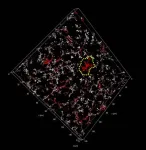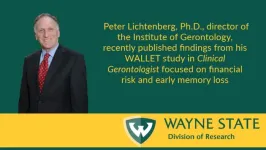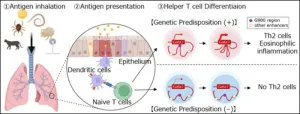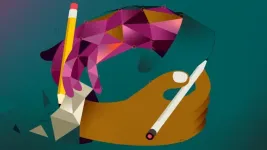(Press-News.org) A new study led by University of Cincinnati researchers sheds new light on the role of a signaling pathway in the brain to maintain health and prevent inflammation and cognitive deficits.
UC’s Agnes (Yu) Luo, PhD, is corresponding author on the research, published June 21 in the journal Nature Communications, and focused on a signaling pathway called TGF-β that plays a number of roles depending on where it is located in the body.
Luo explained that signaling pathways in the body control different cell functions and require two components: a type of molecule called a ligand and a receptor that the ligand binds to and activates to start the signaling.
Prior to this study, it was known that the TGF-β signaling pathway was important in brain immune cells called microglia in maintaining their balance, but its role in maintaining cognitive function was largely unknown. Additionally, the precise source of the TGF-β ligand in the brain was also unknown.
Luo said the researchers used state-of-the-art tools and found for the first time that microglia make the TGF-β ligand in the brain to prevent neuroinflammation.
“Microglia cells are the innate immune cells of the brain, and what surprised us most is that they each make their own TGF-β ligand,” said Luo, professor and vice chair in the Department of Molecular and Cellular Biosciences in UC’s College of Medicine. “This TGF-β ligand binds to the receptor on the microglia cell itself, and they use this signaling to stay in homeostasis. This self-produced ligand binds to receptors on the cell’s surface to keep each cell in a constantly balanced, and not in an inflamed, state.”
While it was previously known that TGF-β signaling helps keep microglia in balance, Luo said it was not known that microglia make the ligands themselves in a “spatially and precisely controlled” manner carried out by each individual cell, a mechanism called autocrine signaling.
“You can think of these microglia cells as being, in a way, ‘selfish,’ as they only make the ligand to keep themselves in balance and not inflamed,” said graduate student and study coauthor Elliot Wegman. “This, thereby, provides a very precise mechanism to regulate local states of inflammation in the microenvironment of the brain.”
Using animal models, the team additionally found that when the TGF-β ligand is genetically deleted from microglia, it leads to global neuroinflammation in the brain.
“This suggests that the neuroinflammation in microglia is sufficient by itself without other causes to drive cognitive deficit,” Luo said. “We show the direct cause and link between these events.”
Moving forward, the team will investigate whether cognitive deficit can be slowed, stopped or potentially reversed by boosting the TGF-β ligand and signaling pathway in the brain under conditions where TGF-β signaling becomes compromised.
“We’re investigating whether restoring the TGF-β signaling pathway and revitalizing its signaling can then ameliorate disease-related or age-associated cognitive deficits,” she said. “The long-term goal of our research is to modify the brain environment to better support the survival of the neurons or promote repair of the brain after injury or damage.”
This study was supported by National Institutes of Health grants (R01NS127074 and F31NS125930). Additional coauthors and collaborators on the paper include UC’s Alicia Bedolla, Max Weed, Kierra Ware, Anastasia Alkhimovitch, Igal Ifergan, Aleksandr Taranov, Joshua D. Peter and Lucas McClain; Messiyah K. Stevens of Vanderbilt University; Rosa Maria Salazar Gonzalez, J. Elliott Robinson, Aditi Paranjpe and Krishna M. Roskin of Cincinnati Children’s Hospital Medical Center and Nigel H. Greig of the National Institutes of Health’s National Institute on Aging
END
University of Cincinnati study: Signaling pathway in brain helps maintain balance, prevent cognitive deficit
Research published in Nature Communications
2024-06-24
ELSE PRESS RELEASES FROM THIS DATE:
Bank statements reveal clues to excessive spending and cognitive decline
2024-06-24
DETROIT -- Early memory loss has been linked to wealth loss, but research has mostly focused on investments. Four years ago, clinical geropsychologist Peter Lichtenberg, Ph.D., wondered what clues might be found in an older person’s financial decisions to indicate their vulnerability to financial victimization. Lichtenberg is director of the Institute of Gerontology at Wayne State University and a national expert in the financial exploitation of older adults. The results of his curiosity have now been published as “The WALLET Study: Financial ...
Even very small amounts of elements in follicular fluid may impact IVF success rates, according to new study from George Mason University researcher
2024-06-24
Though exposure to “trace” (an extremely small amount) elements has been shown to affect ovarian functions in experimental studies, there has been little research on the impact of trace levels of non-essential elements, such as lead (Pb) and mercury (Hg), on female reproduction. Studies have shown that high levels of these non-essential elements may lead to decreased female fertility and reduce the likelihood of getting pregnant. Taken together, this evidence raises concern about the potential negative impact of exposure ...
Study elucidates role of “G900” gene enhancers in asthma-associated inflammation
2024-06-24
Asthma patients experience respiratory distress due to allergens like house dust mites or pollen. However, the various triggers for asthma share a common pathway involving the release of proteins called type-2 cytokines by Type-2 helper T (Th2) cells and group-2 innate lymphoid cells (ILC2s). Both Th2 and ILC2 require high amounts of GATA-binding protein 3 (GATA3) for their maturation.
Specific gene sequences called enhancers are responsible for elevating the expression of GATA3 genes in humans. Studies have found that by controlling the production of GATA3, enhancers influence the development of Th2 and ILC2. The gene region G900, located close to ...
Secrets of drop stains unveiled: New FSU research decodes chemical composition from simple photos
2024-06-24
TALLAHASSEE, Fla. — Imagine zooming in on a dried drop of salt solution — each pattern a unique masterpiece, reminiscent of abstract art, yet no larger than the size of a penny.
New research by scientists in the Florida State University Department of Chemistry and Biochemistry uses the patterns formed by a dried salt solution to train a machine learning algorithm that can identify the chemical composition of different salts. The work will be published in the Proceedings of the National Academy of Sciences.
“We are taking chemical fingerprints ...
New computational model of real neurons could lead to better AI
2024-06-24
Nearly all the neural networks that power modern artificial intelligence tools such as ChatGPT are based on a 1960s-era computational model of a living neuron. A new model developed at the Flatiron Institute’s Center for Computational Neuroscience (CCN) suggests that this decades-old approximation doesn’t capture all the computational abilities that real neurons possess and that this older model is potentially holding back AI development.
The new model developed at CCN posits that individual neurons exert more control over their surroundings than previously thought. The updated neuron model could ultimately lead to more powerful artificial neural ...
AI matches protein interaction partners
2024-06-24
Proteins are the building blocks of life, involved in virtually every biological process. Understanding how proteins interact with each other is crucial for deciphering the complexities of cellular functions, and has significant implications for drug development and the treatment of diseases.
However, predicting which proteins bind together has been a challenging aspect of computational biology, primarily due to the vast diversity and complexity of protein structures. But a new study from the group of Anne-Florence Bitbol at EPFL might now change all that.
The team of scientists, ...
Navigating the labyrinth: How AI tackles complex data sampling
2024-06-24
The world of artificial intelligence (AI) has recently seen significant advancements in generative models, a type of machine-learning algorithms that “learn” patterns from set of data in order to generate new, similar sets of data. Generative models are often used for things like drawing images and natural language generation – a famous example are the models used to develop chatGPT.
Generative models have had remarkable success in various applications, from image and video generation to composing music and to language modeling. The problem ...
Hydrothermal vents on seafloors of ‘ocean worlds’ could support life, new study says
2024-06-24
We’ve all seen the surreal footage in nature documentaries showing hydrothermal vents on the frigid ocean floor—bellowing black plumes of super-hot water—and the life forms that cling to them. Now, a new study by UC Santa Cruz researchers suggests that lower-temperature vents, which are common across Earth's seafloor, may help to create life-supporting conditions on "ocean worlds" in our solar system.
Ocean worlds are planets and moons that have—or had in the past—a liquid ocean, often under an icy shell or within their rocky interior. In Earth's solar system, several of Jupiter's and Saturn's moons are ocean worlds, and ...
New USF study: Mindfulness and managing emotions lead to better sleep
2024-06-24
Media Contact:
John Dudley
(814) 490-3290 (cell)
jjdudley@usf.edu
TAMPA, Fla. (June 24, 2024) – Mindfulness – focusing on the present moment – can improve sleep, reduce stress and improve overall health. A new University of South Florida-led study helps explain why.
Researchers studied 144 nurses over two weeks to see how well they could stay focused on the present and how often they fixated on negative thoughts. The nurses completed surveys three times a day and reported their sleep quality the following morning.
The findings shed light on how mindfulness relates to emotion ...
JACC to serve cardiovascular community, shape future under new editor
2024-06-24
The first issue of JACC, the flagship journal of the American College of Cardiology, under new Editor-in-Chief Harlan M. Krumholz, MD, SM, FACC, publishes today, ushering in a new era of one of the world’s leading scholarly journals.
“I envision JACC, with all its strengths, as a transformative platform for building community, elevating strong science, influencing clinical practice, supporting career development, and improving patient outcomes.” Krumholz said in his Editor’s Page. “JACC and its group of journals can play a pivotal role in serving our community and shaping the future.”
Under his editorship, JACC will be guided by ...
LAST 30 PRESS RELEASES:
Tracing the quick synthesis of an industrially important catalyst
New software sheds light on cancer’s hidden genetic networks
UT Health San Antonio awarded $3 million in CPRIT grants to bolster cancer research and prevention efforts in South Texas
Third symposium spotlights global challenge of new contaminants in China’s fight against pollution
From straw to soil harmony: International team reveals how biochar supercharges carbon-smart farming
Myeloma: How AI is redrawing the map of cancer care
Manhattan E. Charurat, Ph.D., MHS invested as the Homer and Martha Gudelsky Distinguished Professor in Medicine at the University of Maryland School of Medicine
Insilico Medicine’s Pharma.AI Q4 Winter Launch Recap: Revolutionizing drug discovery with cutting-edge AI innovations, accelerating the path to pharmaceutical superintelligence
Nanoplastics have diet-dependent impacts on digestive system health
Brain neuron death occurs throughout life and increases with age, a natural human protein drug may halt neuron death in Alzheimer’s disease
SPIE and CLP announce the recipients of the 2025 Advanced Photonics Young Innovator Award
Lessons from the Caldor Fire’s Christmas Valley ‘Miracle’
Ant societies rose by trading individual protection for collective power
Research reveals how ancient viral DNA shapes early embryonic development
A molecular gatekeeper that controls protein synthesis
New ‘cloaking device’ concept to shield sensitive tech from magnetic fields
Researchers show impact of mountain building and climate change on alpine biodiversity
Study models the transition from Neanderthals to modern humans in Europe
University of Phoenix College of Doctoral Studies releases white paper on AI-driven skilling to reduce burnout and restore worker autonomy
AIs fail at the game of visual “telephone”
The levers for a sustainable food system
Potential changes in US homelessness by ending federal support for housing first programs
Vulnerability of large language models to prompt injection when providing medical advice
Researchers develop new system for high-energy-density, long-life, multi-electron transfer bromine-based flow batteries
Ending federal support for housing first programs could increase U.S. homelessness by 5% in one year, new JAMA study finds
New research uncovers molecular ‘safety switch’ shielding cancers from immune attack
Bacteria resisting viral infection can still sink carbon to ocean floor
Younger biological age may increase depression risk in older women during COVID-19
Bharat Innovates 2026 National Basecamp Showcases India’s Most Promising Deep-Tech Ventures
Here’s what determines whether your income level rises or falls
[Press-News.org] University of Cincinnati study: Signaling pathway in brain helps maintain balance, prevent cognitive deficitResearch published in Nature Communications









